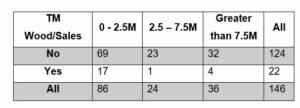By Juan Gonzalez. MS candidate, email jjgoco02@vt.edu
The current market of Thermally Modified (TM) is still affected by the lack of performance information and clear specification of advantages and limitations of the material over competing products. Such information is needed so new potential users like architects can make informed decisions regarding material selection. The objective of this article is to know the level of awareness of TM wood and if there are differences between the size of architectural businesses and awareness on TM wood. Espinoza (2015), where he studied marketing strategies from the perception of TM wood producers. His results showed that the awareness of TM wood across the United States (US) is very low.
The survey and sample
A survey was recently conducted by a team of Virginia Tech researchers to study the perception of the TM wood U.S market, with focus on east coast architects. Besides marketing perceptions and awareness of TM wood, the survey also included questions related to the mechanical performance (bending, modulus of elasticity, and surface hardness, shrinkage), and visual aspects (color) of TM wood.
The sample frame included companies under NAICS 541310 and 541320 (Architectural Services and Landscape Architectural Services) subscribed to the Commerce of Chamber on the most populated counties in the East Coast of the U.S. The survey was distributed using paper and web versions. The standard managing survey procedures were followed. Once the survey period was closed, all returned questionnaires were revised for accuracy and content reliability.
Preliminary Results
A total of 146 responses were obtained from the surveyed sample (web and paper). Out of the total responses, 49 came from the paper survey and 107 from the web survey. These 146 responses correspond to 1.825%, from a population of 8,000. Out of the total responses, only 22 of the respondents answered that they have worked with TM wood products and continued the survey. With only 22 respondents indicating they worked with TM wood, the results limit the extrapolation of the conclusions and results toward the entire population. However, this is an indication that still there is little awareness of TM wood among the architectural community in the east coast of the United States.
Table 1 summarizes the results of the awareness of TM wood question by company size. Seventeen of the 22 companies that have worked with TM wood are considered small, 1 medium and 4 large.

Using a contingency analysis, we tested the hypothesis that awareness is dependent on the size of the business.
• Ho: Awareness is dependent of the company size
• H1: Awareness is not dependent on the company size
It was found that there is a statistical difference using a chi-square test (P-value < 0.001). Hence we concluded that smaller businesses are more aware of TM wood than larger ones.
Reference
• Espinoza, O., Buehlmann, U., & Laguarda-Mallo, M. F. (2015). Thermally modified wood: marketing strategies of US producers. BioResources, 10(4), 6942-6952.
